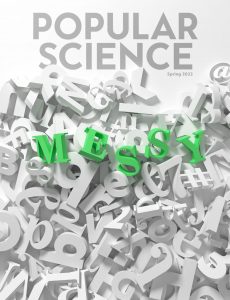
Popular Science USA – Spring 2022
English | 80 pages | pdf | 40.05 MB
Welcome at Popular Science USA magazine Spring 2022 Issue
I STILL REMEMBER my first oxymoron. I was sitting cross-legged on the living room floor watching The Joy of Painting on PBS when Bob Ross uttered the phrase “happy accidents.” I cocked my 5-year-old head to one side, puzzling over the implication that I could somehow feel good about spilled milk, scraped knees, and broken eyeglasses. But watching him wield a palette knife to scrape the shape of a stream over some rough, low-lying shrubs, I soon understood what he was getting at: that we can find ways to turn our mistakes into gold.
There’s just one problem with the bushy haired painter’s catchphrase: The accident itself isn’t what’s making happiness. We’re the ones who embrace the error and make
something splendid happen—be it by turning a clumsy brushstroke into a peaceful stream or, somewhat famously, finding penicillin in neglected petri dishes. That’s why, as an adult and an editor, I’ve instead adopted the (admittedly cringeworthy) phrase “problem- tunity” for such events.
Of course, that thinking applies to almost every story we’ve published here at PopSci in our nearly 150 years of existence. The most impressive innovations are those that stand to solve our most pressing problems, and those hurdles are, more often than not, the results of our own missteps. That last bit is what we’re often tempted to shy away from.
Instead, this issue posits, we should relish looking closely at the messes themselves for insights and inspiration. Sarah Scoles finds one inside a toxically sulfuric cave, where explorers find extremophile worms that could unlock future antibiotics. Virginia Gewin chronicles another as she follows efforts to trace the spread of dust in the US Southwest in the hope that new insights will lead to better management. Sara Kiley Watson meanwhile sniffs out the reality of turning our heaps of methane- belching trash into energy. And Leigh Cowart spotlights 10 of science’s filthiest jobs—from mosquito feeder to maggot farmer.
Reveling in all that dirt, gunk, and funk is good for us (literally: It’s called the hygiene hypothesis, and we get into that too), so why sweep it under the proverbial rug? We can clean up messes—we should and we will— but that doesn’t mean we can’t find out what our spills and stains have to tell us first
Download from:
One Response to “Popular Science USA – Spring 2022”